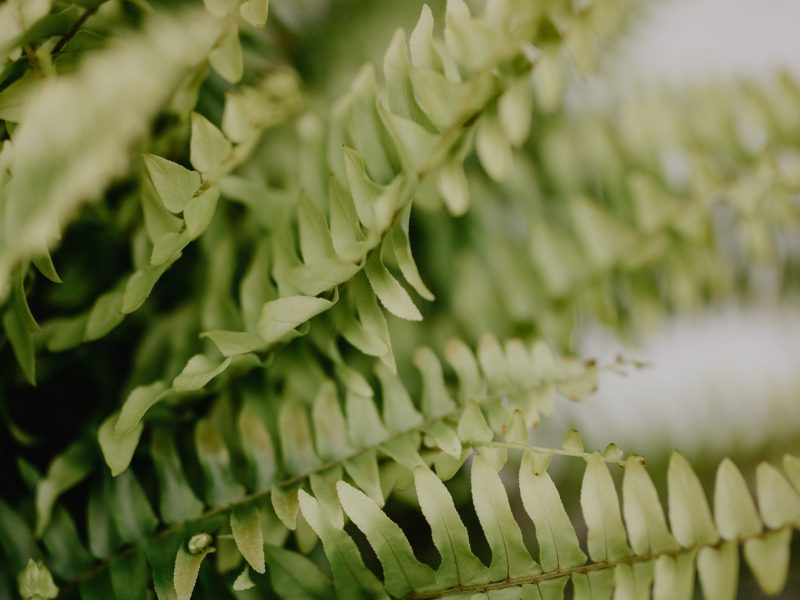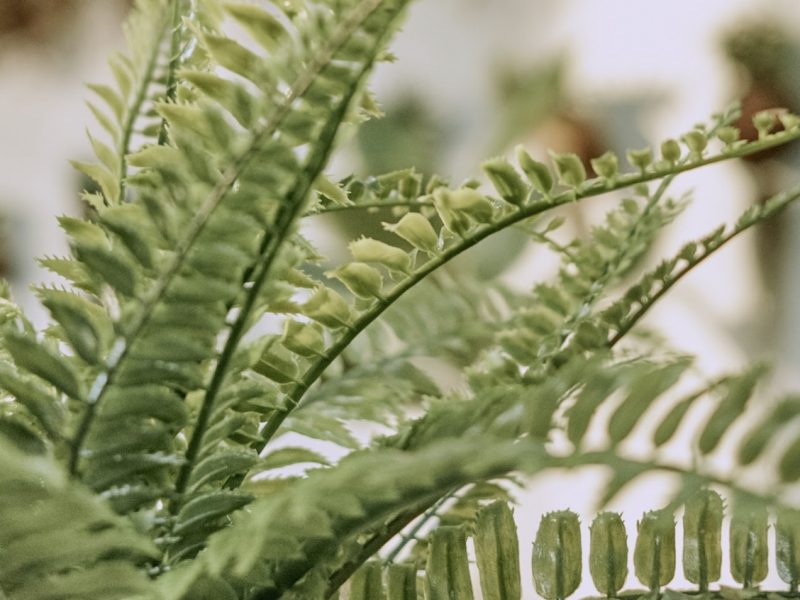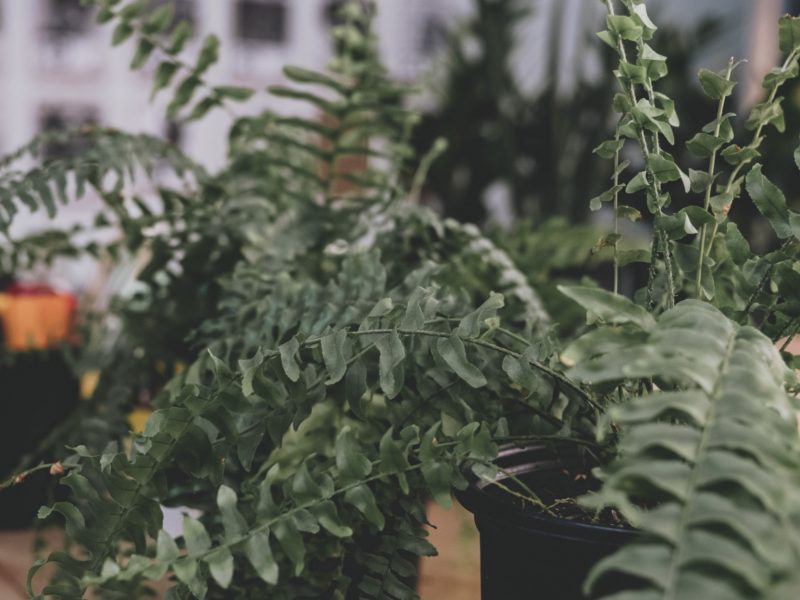
Causes of brown leaves on Boston Ferns
Intense direct sunlight can cause brown leaves
Lighting is always an important element to take into consideration when caring for your houseplants and things are no different with the Boston Fern. In fact, Ferns in general are one of the most sensitive houseplant types when it comes to light as they often have such thin delicate leaves.
If your Boston Fern is getting too much bright light you’ll start to notice brown patches throughout your plant but primarily on the side that is facing the window. This is due to the sunlight burning the delicate leaves on your Boston Fern which is unfortunately irreversible.
Even a few hours of intense direct sunlight during summer can be enough to dry out your Boston Fern so it’s crucial that you don’t take any chances when it comes to finding the right placement for your fern.
Extreme temperatures
Another factor that can harm your Boston Fern is really high or low temperatures. It can happen that your Boston Fern gets exposed to cold drafts coming in from outside, cold streams of air from AC vents or on the other extreme, warm air from radiators or cookers can dry out the plant.
Either of these extremes may cause your Boston Fern to develop brown crispy leaves so make sure to check your plant’s environment for any hotspots or cold drafts.
A consistent lack of water
If the leaves on your Boston Fern have gone quite brown but dry, then too little water might be why your plant is struggling. Boston Ferns in particular are quite heavy drinkers so will require more frequent watering compared to a lot of your other plants.
The best way to determine if dry soil is causing the leaves on your Boston Fern to turn brown is by picking up your plant. Because they have such delicate thin stems, leaves and roots, they will be extremely light if there is no water in the soil. This is why picking them up is a simple way to know just how much water is in the soil. Alternatively, you can use a moisture meter or the chopstick method.
Low humidity levels can also cause dry brown leaves
If you’re confident that you’re keeping your watering habits in check, then low humidity could be the cause of your Boston Fern’s leaf browning. It’s a very common issue with Boston Ferns as they require quite a high and constant level of humidity.
A common telltale sign of a lack of humidity is dry leaf edges before the whole leaf turns brown so take a close look at the leaves across your plant.
Humidity is a tricky one to test for without a humidity monitor so we highly recommend picking up one of these.
Cold temperatures can cause brown foliage on your Boston Fern

Solutions for brown leaves on Boston Ferns
Find the most suitable spot for your Boston Fern
To avoid issues caused by too much sunlight, we recommend moving your Boston Fern into a slightly shadier place, and if there’s no improvement move it a little further again until you find it’s the perfect spot.
And to avoid any extreme temperatures, ventilate the room well and keep all plants at least 1 metre away from radiators, heaters or cookers. You may also want to invest in a digital thermometer to keep track of how the temperature changes throughout the seasons and make sure your Boston Fern is in its ideal range to avoid brown leaves.
You may be wondering what to do with the brown leaves that have already developed. Our recommendation is to carefully trim away the brown leaves so your Boston Fern can focus all of its energy on new healthy growth. Once a leaf or a stem has turned brown, there is no reversing this unfortunately so it’s best to remove it altogether.
Adjust your watering habits
If the soil is very powdery and dry and underwatering is causing your Boston Fern to turn brown, then you should slowly reintroduce water to raise the moisture levels in the soil. You may think that the best way to solve underwatering is simply by pouring a bucket of water over your Boston Fern. However, if their environment goes from one extreme to the other very quickly, it can actually cause them to become shocked and stressed. This is why gradually increasing the moisture in the soil over the course of a week is the best way.
Give the humidity a boost
If a lack of humidity is causing the brown leaves on your Boston Fern then it’s super easy to solve! There are several ways you can really quickly (and cheaply) raise the humidity level for your Boston Fern:
Mist the leaves daily
Use a spray bottle to mist the leaves once a day during summer and a few times per week during winter. This also helps to clean the plant (as Boston Ferns can be a little tricky to clean as they are so delicate) so it’s a win-win! Regular misting also has the benefit of keeping the humidity level stable over time.
Showering your Boston Fern
If you’re looking for a quick fix, washing down the leaves is a great way to boost the humidity for your Boston Fern. Showing in the normal way isn’t that suitable for a Boston Fern as they are just so delicate and even low water pressure can cause issues.
Instead, you can either submerge your plant in water, or dunk parts of the plant in a bucket full of water to moisten the plant.
Move to a more humid room
If you have good lighting in your bathroom then we recommend moving your Boston Fern in there. The humidity level in those rooms is naturally higher because of showering and your Boston Fern will love it in there!
Buy a humidifier
If you’re worried about the lack of humidity becoming a real problem, then buying a humidifier is probably the best thing for you. It keeps the humidity in the room at a consistent level so you don’t have to worry about any more dry brown leaves developing on your plant. But the benefits of humidifiers don’t stop at your houseplants, they are even great at clearing our skin and helping us get a better night’s sleep.
We always recommend this humidifier from Amazon as a great place to start.
Intense light can cause brown leaves on a Boston Fern

How to prevent brown leaves on a Boston Fern
Monitor the environment
The best way to prevent brown leaves from developing on your Boston Fern is to monitor your plant’s environment to spot any issues before they impact your plant. There are a few main things to be checking; temperature, light level and humidity.
When it comes to temperature, one of the best things we did was to buy a digital thermometer for every room. This way we can monitor the temperature around our home, moving it to different spots to make sure that there are no hotspots or drafts affecting your plants.
Try to buy one that has a setting whereby you can see the highest and lowest temperature over the past 24 hours. This will help you know if there are any sudden fluctuations in temperature overnight or during the day when you aren’t home.
Light level is also an important one to monitor not only throughout the day but throughout the year as the sun’s position changes dramatically. Areas that might not get much light during winter can receive intense sunlight during summer so make sure to always be checking in with how much light your Boston Fern and other houseplants are receiving.
Don’t let soil dry out
This is our number one rule when it comes to caring for Boston Ferns and preventing issues such as brown leaves. Boston Ferns are thirsty plants and require frequent watering.
We also don’t believe in a rigid watering schedule so you should be monitoring your plant’s soil frequently to see how changes in the environment (season for example) impact how much water your Boston Fern needs.
Get into long-term habit of misting
During spring and summer (and early autumn if it’s still warm), we strongly recommend misting your Boston Fern at least 3-4 times per week to prevent dry brown leaves. Forming this habit will be invaluable to your plant’s overall health!
Why are the leaves on my Boston fern turning brown?
Brown leaves on a Boston Fern are often caused by either underwatering or a lack of humidity. However, they can also be caused by intense sunlight and temperature extremes.
Is it normal for Boston ferns to develop brown leaves?
Whilst some brown leaves can be a sign of natural ageing, if your Boston Fern is rapidly turning brown, then this is likely caused by underwatering, a lack of humidity or hotspots drying out the leaves. Check the soil moisture as well as the temperature and humidity level around your plant to determine the most likely cause.
Can too much sunlight cause Boston Ferns to turn brown?
Yes, if your Boston Fern is receiving several hours of intense sunlight during summer, this can dry out the leaves and cause them to turn brown. Direct sunlight during winter though won’t cause much of an issue as the sun is a lot weaker and is out for less of the day. This is why moving your Boston Fern (and other houseplants) around throughout the year can be really beneficial.
Should I prune my Boston fern if it has brown leaves?
We recommend removing the brown leaves on your Boston Fern so that your plant can focus its energy on producing new healthy, and green, leaves.
How can I prevent brown leaves on my Boston Fern?
Consistently monitoring your plant’s environment (temperature, light level and humidity) alongside the soil moisture will help you spot any issues before they damage your plant’s health. Make sure that you avoid your plant drying out as much as possible as dry soil can very quickly lead to brown leaves throughout your Boston Fern.
How do I fix a brown Boston Fern?
Start by removing any dead brown leaves and trim away any dead crispy roots so that your Boston Fern can focus on regenerating healthy growth. Then adjust your watering schedule if you have been underwatering or fix any environmental issues such as light level, temperature or humidity level if they have been causing issues with your plant.
Those are the most common reasons why Boston Fern plants develop brown leaves. It can be quite a common issue for Boston Ferns as they are very sensitive and have super delicate leaves so just make sure you are staying on top of watering and boosting the humidity and this will go a long way to avoiding brown dry leaves.
It’s important to note here though that some brown foliage is normal for Boston Ferns and if the rate is lower than the rate of new healthy growth, then it can be nothing to worry about. Thoroughly checking up on your plant every few weeks can go a long way to spotting any issues before they have had time to cause brown leaves or any other problems.
To find out more about how to best care for your fern, as well as how to spot and treat other common problems that might arise with your plant, check out our Boston Fern care guide.














